ASUS Striker II Formula under the Microscope
by Rajinder Gill on March 19, 2008 4:00 AM EST- Posted in
- Motherboards
Board Layout and Features - ASUS Striker II Formula
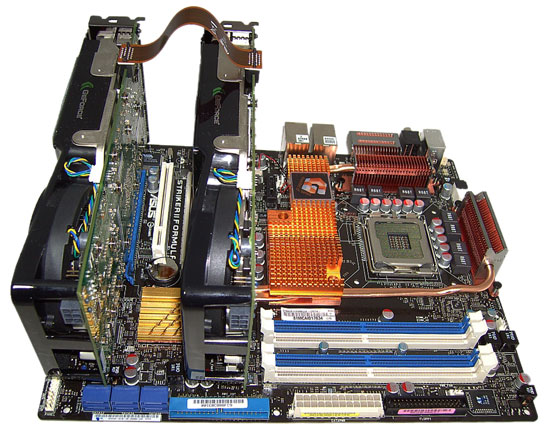 |
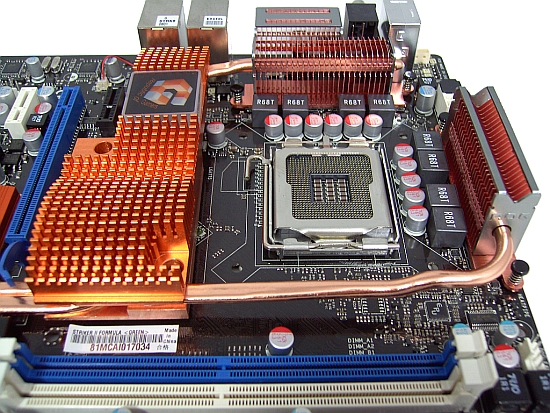 |
ASUS sticks with the tried and tested 8-phase CPU power circuit they have used for the past two years along with the regular array of heatsinks and heatpipes. Most air-cooling solutions should fit fine, though access to thumbscrews will be a little tight for coolers like the Tuniq Tower. The EPS 12V connector is at the top corner of the board. The CPU fan header is near the memory slots in the lower right corner of the picture. Seven system fan headers are located across the board to provide a variety of locations for attaching fans. Fan control is offered in the BIOS and via ASUS' own software, though the level of customization does not match that of abit's µGuru utility.
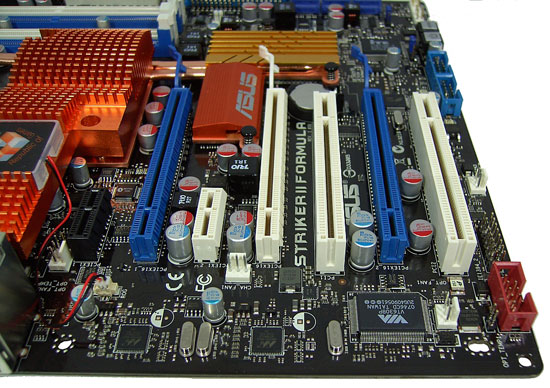 |
The PCI-E 2.0 compatible slots are far enough apart to allow a third graphics card to be used in the white PCI-E 1.1 x16 slot. The supplied Supreme FX II soundcard uses the black PCI-E x1 connector above the top PEG slot. Using dual graphics cards allows the use of the central PCI slot. When three air-cooled graphics cards are used, all other expansion slots (apart from the soundcard connector) are blocked.
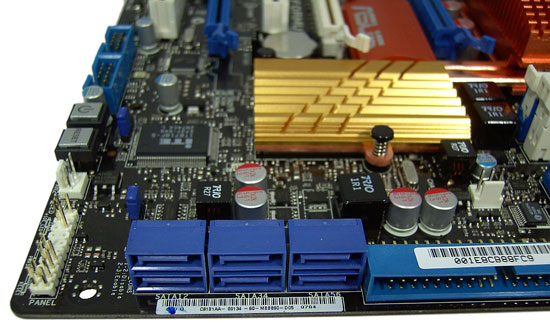 |
Six 3Gbps SATA ports capable of RAID 0, 1, 0+1, 5 and JBOD arrays are located at the edge of the board. The IDE connector is placed to the right of the SATA ports and has enough clearance from the PEG slots to allow access at all times. Power and reset buttons are at the lower edge of the board, for users who run open testbeds.
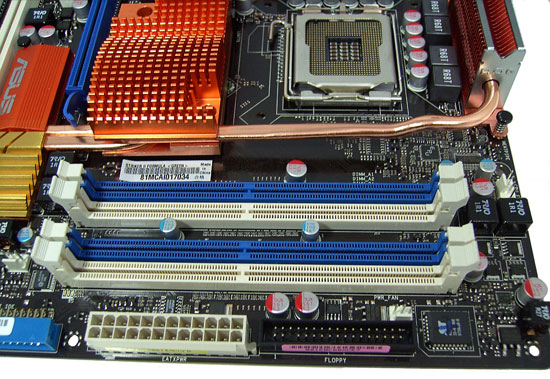 |
The ATX 12V connector is adjacent to the memory slots, with the 3.5" floppy connector placed to its right. Interestingly enough ASUS has employed a 2-phase memory power circuit using the low RDS MOSFETs we often see on their DDR3-based motherboards. This should allow extra overhead when using double density modules for 8GB memory overclocking - we will test this in a few pages.










18 Comments
View All Comments
glasforex - Tuesday, October 7, 2008 - link
thanks for the review and thanks guys for the coments. they helped me achive a 400mhz fsb clock(1600) on my e7200 taking it from 2.5-> 3.8Ghzexample:
load setup defaults
manual
spp-m.. 200
fsb to mem...linked
sync mode
fsb 1600
mem 800
c1 state - disable, disable bit - disable...
and everything there - disable... except use 2 or 4 cores
auto voltages.
my vga nvidia 9800GX2.
It was a significant performance improvement.
ps: guys remember to load defaults in bios every time before you want to do something with this mobo... strange.
Slavek - Thursday, March 20, 2008 - link
Good day! I would this motherboard: Asus Striker II Formula buy ,but I want know if is power motherboard and if is production of high-quality kit. ThanksRajinder Gill - Thursday, March 20, 2008 - link
Hi,For dual core processors + if you want to run SLI, this board works fine. If using quad core processors, you really need an unlocked multipler CPU in order to achieve high clock speeds. Despite hearsay, I found the board to work very well using the 1101 BIOS and my E8500. Using this combination of parts left me with nothing to grumble about. Performance in Sync mode at around 475FSB using the 1101 BIOS is fine and does not leave much to be desired IMO.
regards
Raja
electricx - Saturday, March 22, 2008 - link
It should be terribly interesting to see what the Striker II Extreme could offer to deal with the quirks this board is presenting. One could speculate quite a bit, especially based on the praise AT has lavished upon the 790i so far. I expect performance bordering on rediculous with a ROG board that I'll never own. But for me it's not about owning, it's about drooling. muhuhhahahahha.Amuro - Friday, March 21, 2008 - link
In this blog article, Gary Key was able to push the FSB to 450mhz with the QX9650 and BIOS 0901:http://www.anandtech.com/weblog/showpost.aspx?i=37...">http://www.anandtech.com/weblog/showpost.aspx?i=37...
Maybe 1101 is just not for quads.
Rajinder Gill - Friday, March 21, 2008 - link
Hi,The 0901 has instability issues in many ways. Other than Everest, there's little else the board will do at 450FSB (even in the 0901 BIOS). The screenshots were only really shown for the low memory access latency. Later on, it was discovered that 450 FSB and the low access latency was nothing more that a pipe-dream for real world application stability.
regards
Raja
Amuro - Wednesday, March 19, 2008 - link
I'm using a QX9650 with the Striker II Formula and 4.0Ghz (400x10) is Prime stable with the 0902 BIOS that my board came with. However, with the latest 1101 BIOS, I couldn't even boot into Windows with the same overclock, so I had to revert back to 0902. There's definitely some issues with the 1101 BIOS and QX9650.ianken - Wednesday, March 19, 2008 - link
other than the NICs failing after resuming from S3, my board has been rock solid.lopri - Wednesday, March 19, 2008 - link
When can we expect these high speed 2GB DDR2 sticks? Is it possible to let us know what IC will be used for these sticks? (Micron? Powerchips? Infineon? Samsung?) Thank you. ^^Endless/uncontrollable reboots? :D
skinflickBOB - Thursday, March 20, 2008 - link
I could not care less about the chips as long as they do what it says on the 'tin'. 1200MHz sounds cool, I would imagine that some of the die advancements from DDR3 are beginning to filter down into DDR2. But like I said, as long as they do 1200MHz - as stated, that's fine for moi..later days